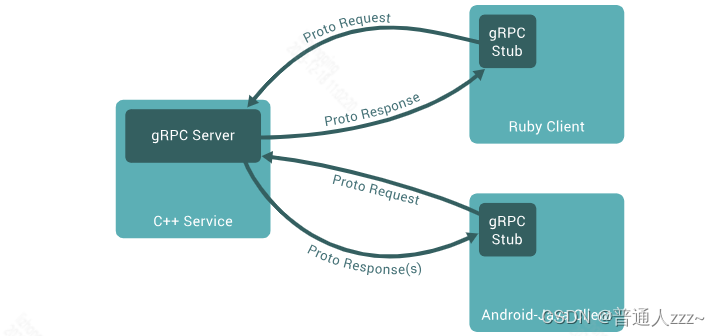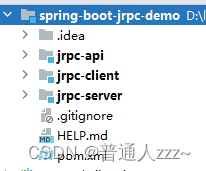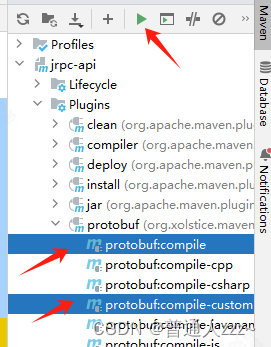SpringBoot基于gRPC进行RPC调用
SpringBoot基于gRPC进行RPC调用
一、gRPC
1.1 什么是gRPC?
In gRPC, a client application can directly call a method on a server application on a different machine as if it were a local object, making it easier for you to create distributed applications and services. As in many RPC systems, gRPC is based around the idea of defining a service, specifying the methods that can be called remotely with their parameters and return types. On the server side, the server implements this interface and runs a gRPC server to handle client calls. On the client side, the client has a stub (referred to as just a client in some languages) that provides the same methods as the server.
在 gRPC 中,客户端应用程序可以直接调用服务器应用程序上的方法 在另一台机器上,就好像它是本地对象一样,使你更容易 创建分布式应用程序和服务。与许多 RPC 系统一样,gRPC 是 基于定义服务的思想,指定可以 使用其参数和返回类型进行远程调用。在服务器端, server 实现此接口并运行 gRPC 服务器来处理客户端调用。 在客户端,客户端有一个存根(在某些客户端中称为客户端 languages),它提供与服务器相同的方法。

gRPC 客户端和服务器可以在各种 环境 - 从 Google 内部的服务器到您自己的桌面 - 并且可以 用 gRPC 支持的任何语言编写。因此,例如,您可以轻松地 在 Java 中创建一个 gRPC 服务器,客户端使用 Go、Python 或 Ruby。另外 最新的 Google API 将具有其接口的 gRPC 版本,让您 轻松将 Google 功能构建到您的应用程序中。
gRPC 使用 proto buffers 作为服务定义语言,编写 proto 文件,即可完成服务的定义。

1.2 如何编写proto
syntax = "proto3";
option java_multiple_files = true;
// 生成位置
option java_package = "com.lizq.jrpc.api";
option java_outer_classname = "UserService";
package user;
service User {
rpc SayHello (UserRequest) returns (UserResponse) {}
}
message UserRequest {
string name = 1;
int32 age = 2;
string addr = 3;
}
message UserResponse {
string name = 1;
int32 age = 2;
string addr = 3;
OtherMsg otherMsg = 4;
map<string, string> otherMap = 5;
// 嵌套对象
message OtherMsg {
string ext1 = 1;
string ext2 = 2;
}
}
syntax = "proto3";:指定使用的protobuf版本;option java_multiple_files = true;:如果为 false,则只会.java为此文件生成一个.proto文件,以及所有 Java 类/枚举/等。为顶级消息、服务和枚举生成的将嵌套在外部类中。如果为 true,.java将为每个 Java 类/枚举/等生成单独的文件。为顶级消息、服务和枚举生成,并且为此.proto文件生成的包装 Java 类将不包含任何嵌套类/枚举/等。 如果不生成 Java 代码,则此选项无效。package user;:定义本服务的包名,避免不同服务相同消息类型产生冲突;option java_package = "com.lizq.jrpc.api";:生成java文件包名;option java_outer_classname = "UserService";:生成java文件类名称。如果文件中没有明确 java_outer_classname指定,.proto则将通过将.proto文件名转换为驼峰式来构造类名(因此 foo_bar.proto变为FooBar.java)message UserResponse:定义服务的接口名称;rpc SayHello (UserRequest) returns (UserResponse) {}:远程调用方法名,参数及响应类型;message XXXXX{}:定义数据类型;
1.3 数据类型及对应关系
| .proto类型 | Notes | C++ Type | Java/Kotlin | Python |
|---|---|---|---|---|
| double | double | double | float | |
| float | float | float | float | |
| int32 | 使用可变长度编码。对负数进行编码效率低下——如果您的字段可能有负值,请改用 sint32。 | int32 | int | int |
| int64 | 使用可变长度编码。对负数进行编码效率低下——如果您的字段可能有负值,请改用 sint64。 | int64 | long | int/long |
| uint32 | 使用可变长度编码。 | uint32 | int | int/long |
| uint64 | 使用可变长度编码。 | uint64 | long | int/long |
| sint32 | 使用可变长度编码。带符号的 int 值。这些比常规 int32 更有效地编码负数。 | int32 | int | int |
| sint64 | 使用可变长度编码。带符号的 int 值。这些比常规 int64 更有效地编码负数。 | int64 | long | int/long |
| fixed32 | 总是四个字节。如果值通常大于 228,则比 uint32 更有效 | uint32 | int | int/long |
| fixed64 | 总是八个字节。如果值通常大于 256,则比 uint64 更有效。 | uint64 | long | int/long |
| sfixed32 | 总是四个字节。 | int32 | int | int |
| sfixed64 | 总是八个字节。 | int64 | long | int/long |
| bool | bool | boolean | bool | |
| string | 字符串必须始终包含 UTF-8 编码或 7 位 ASCII 文本,并且不能超过 232。 | string | String | str/unicode |
| bytes | 可能包含不超过 2 32的任意字节序列。 | string | ByteString | str (Python 2)、bytes (Python 3) |
1.4 枚举
enum Sex {
NONE = 0;
MAN = 1;
WOMAN = 2;
}
message UserRequest {
string name = 1;
int32 age = 2;
string addr = 3;
Sex sex = 4;
}
**注意:**第一个枚举的值必须为0,因为0 是默认值,0 必须是第一个,保持和proto2 兼容
1.5 数组
使用 repeated 关键字来定义数组。
message UserRequest {
string name = 1;
int32 age = 2;
string addr = 3;
Sex sex = 4;
// 定义一个数组
repeated string cellphones = 5;
}
1.6 map类型
在开发的过程中经常需要使用关联字段,很自然的想到使用map,protobuf也提供了map的类型。
message UserResponse {
string name = 1;
map<string, string> otherMap = 2;
}
注意: map 字段前面不能是repeated
1.7 嵌套对象
message UserResponse {
string name = 1;
int32 age = 2;
string addr = 3;
OtherMsg otherMsg = 4;
map<string, string> otherMap = 5;
// 嵌套对象
message OtherMsg {
string ext1 = 1;
string ext2 = 2;
}
}
二、SpringBoot gRPC
2.1 工程目录

2.2 jrpc-api
2.2.1 引入gRPC依赖
<dependency>
<groupId>io.grpc</groupId>
<artifactId>grpc-all</artifactId>
<version>1.28.1</version>
</dependency>
2.2.2 编写 .proto 文件
syntax = "proto3";
option java_multiple_files = true;
// 生成位置
option java_package = "com.lizq.jrpc.api";
option java_outer_classname = "UserService";
package user;
service User {
rpc SayHello (UserRequest) returns (UserResponse) {}
}
message UserRequest {
string name = 1;
int32 age = 2;
string addr = 3;
}
message UserResponse {
string name = 1;
int32 age = 2;
string addr = 3;
OtherMsg otherMsg = 4;
map<string, string> otherMap = 5;
// 嵌套对象
message OtherMsg {
string ext1 = 1;
string ext2 = 2;
}
}
2.2.3 使用插件机制生产proto相关文件
在 jrpc-api pom.xml 中添加如下:
<build>
<extensions>
<extension>
<groupId>kr.motd.maven</groupId>
<artifactId>os-maven-plugin</artifactId>
<version>1.6.2</version>
</extension>
</extensions>
<plugins>
<plugin>
<groupId>org.xolstice.maven.plugins</groupId>
<artifactId>protobuf-maven-plugin</artifactId>
<version>0.6.1</version>
<configuration>
<!--<!– ${os.detected.classifier} 变量由${os.detected.name} 和 ${os.detected.arch} 组成-->
<protocArtifact>com.google.protobuf:protoc:3.12.0:exe:${os.detected.classifier}</protocArtifact>
<pluginId>grpc-java</pluginId>
<pluginArtifact>io.grpc:protoc-gen-grpc-java:1.28.1:exe:${os.detected.classifier}</pluginArtifact>
<!--protoSourceRoot 默认src/main/proto-->
<protoSourceRoot>src/main/proto</protoSourceRoot>
</configuration>
<executions>
<execution>
<goals>
<goal>compile</goal>
<goal>compile-custom</goal>
</goals>
</execution>
</executions>
</plugin>
</plugins>
</build>
执行命令生产proto相关文件

将生成的文件拷贝到工程中,如下:

2.2 jrpc-server
jrpc-server 为 springboot 项目。
2.2.1 引入 jrpc-api 依赖
<dependency>
<groupId>com.example</groupId>
<artifactId>jrpc-api</artifactId>
<version>1.0.0-SNAPSHOT</version>
</dependency>
2.2.2 编写impl
@Service
public class UserServiceImpl extends UserGrpc.UserImplBase {
@Override
public void sayHello(UserRequest request, StreamObserver<UserResponse> responseObserver) {
Map<String, String> otherMap = new HashMap<>();
otherMap.put("test", "testmap");
UserResponse response = UserResponse.newBuilder()
.setName("server:" + request.getName())
.setAddr("server:" + request.getAddr())
.setAge(request.getAge())
.setOtherMsg(UserResponse.OtherMsg.newBuilder()
.setExt1("ext1")
.setExt2("ext2")
.build())
.putAllOtherMap(otherMap)
.build();
responseObserver.onNext(response);
responseObserver.onCompleted();
}
}
2.2.3 编写Config
@Configuration
public class GrpcServerConfiguration {
@Value("${grpc.server-port}")
private int port;
@Bean
public Server server() throws Exception {
System.out.println("Starting gRPC on port {}." + port);
// 构建服务端
ServerBuilder<?> serverBuilder = ServerBuilder.forPort(port);
// 添加需要暴露的接口
this.addService(serverBuilder);
// start
Server server = serverBuilder.build().start();
System.out.println("gRPC server started, listening on {}." + port);
// 添加服务端关闭的逻辑
Runtime.getRuntime().addShutdownHook(new Thread(() -> {
System.out.println("Shutting down gRPC server.");
if (server != null) {
// 关闭服务端
server.shutdown();
}
System.out.println("gRPC server shut down successfully.");
}));
if (server != null) {
// 服务端启动后直到应用关闭都处于阻塞状态,方便接收请求
server.awaitTermination();
}
return server;
}
@Autowired
private UserServiceImpl userService;
/**
* 添加需要暴露的接口
* @param serverBuilder
*/
private void addService(ServerBuilder<?> serverBuilder) {
serverBuilder.addService(userService);
}
}
2.2.4 yaml
server:
port: 8081
spring:
application:
name: spring-boot-jrpc-server
grpc:
server-port: 18081
2.3 jrpc-client
2.3.1 引入 jrpc-api 依赖
<dependency>
<groupId>com.example</groupId>
<artifactId>jrpc-api</artifactId>
<version>1.0.0-SNAPSHOT</version>
</dependency>
2.3.2 编写config
@Configuration
public class GrpcClientConfiguration {
@Value("${server-host}")
private String host;
/**
* gRPC Server的端口
*/
@Value("${server-port}")
private int port;
@Bean
public ManagedChannel managedChannel() {
// 开启gRPC客户端
ManagedChannel managedChannel = ManagedChannelBuilder.forAddress(host, port).usePlaintext().build();
System.out.println("gRPC client started, server address: " + host + " , " + port);
// 添加客户端关闭的逻辑
Runtime.getRuntime().addShutdownHook(new Thread(() -> {
try {
// 调用shutdown方法后等待1秒关闭channel
managedChannel.shutdown().awaitTermination(1, TimeUnit.SECONDS);
System.out.println("gRPC client shut down successfully.");
} catch (InterruptedException e) {
e.printStackTrace();
}
}));
return managedChannel;
}
@Autowired
private ManagedChannel managedChannel;
@Bean
public UserGrpc.UserBlockingStub userBlockingStub(ManagedChannel channel) {
// 通过channel获取到服务端的stub
return UserGrpc.newBlockingStub(managedChannel);
}
}
2.3.3 yaml
server:
port: 8080
spring:
application:
name: spring-boot-jrpc-client
# 本地测试
server-host: 127.0.0.1
server-port: 18081
2.3.4 测试验证
@RestController("/user")
public class UserController {
@Autowired
private UserGrpc.UserBlockingStub userBlockingStub;
@GetMapping("/sayHello")
public String sayHello(String name, String addr, int age) {
UserRequest request = UserRequest.newBuilder()
.setName(name)
.setAddr(addr)
.setAge(age)
.build();
UserResponse response;
try {
response = userBlockingStub.sayHello(request);
} catch (StatusRuntimeException e) {
e.printStackTrace();
return e.getMessage();
}
return response.toString();
}
}
浏览器访问:http://localhost:8080/user/sayHello?name=test&addr=addr&age=99 返回:
name: "server:test" age: 99 addr: "server:addr" otherMsg { ext1: "ext1" ext2: "ext2" } otherMap { key: "test" value: "testmap" }
本文来自互联网用户投稿,该文观点仅代表作者本人,不代表本站立场。本站仅提供信息存储空间服务,不拥有所有权,不承担相关法律责任。 如若内容造成侵权/违法违规/事实不符,请联系我的编程经验分享网邮箱:chenni525@qq.com进行投诉反馈,一经查实,立即删除!
- Python教程
- 深入理解 MySQL 中的 HAVING 关键字和聚合函数
- Qt之QChar编码(1)
- MyBatis入门基础篇
- 用Python脚本实现FFmpeg批量转换
- 多号发圈,又可以定时发布怎么设置?我来教你!
- Sentinel 流量治理组件教程
- 学习vue3(一)
- 基于java web的机票管理系统设计与实现设计与实现
- selenium学习
- Go : ssh操作(五)功能集合
- Plantuml之组件图语法介绍(二十二)
- Codeforces Round 890 (Div. 2) supported by Constructor Institute补题
- AcWing 846. 树的重心(dfs)
- 中国林业和草原统计年鉴数据,2001-2019年,可看示例数据